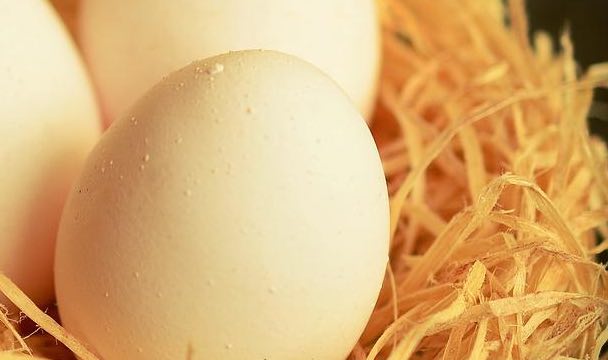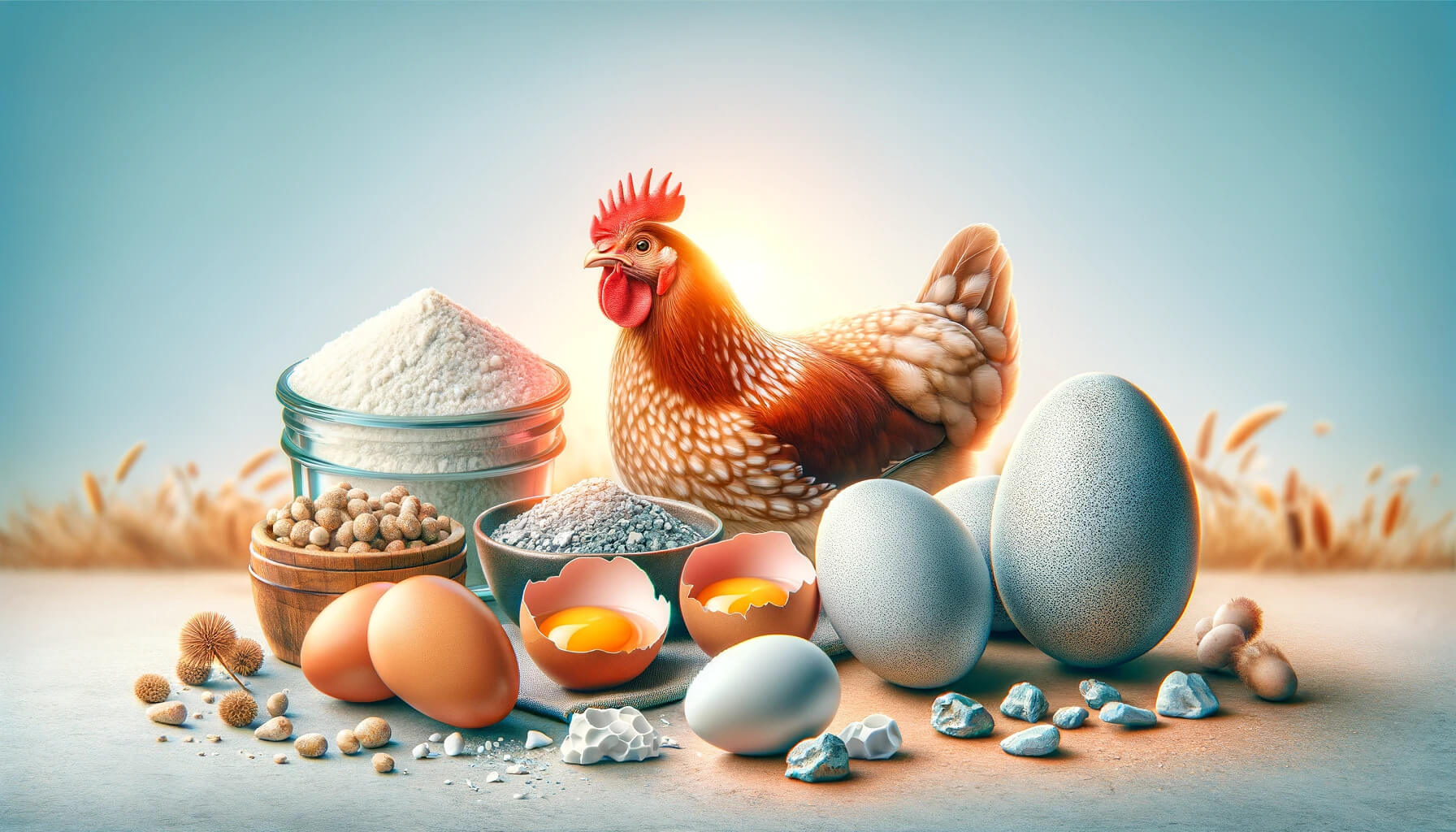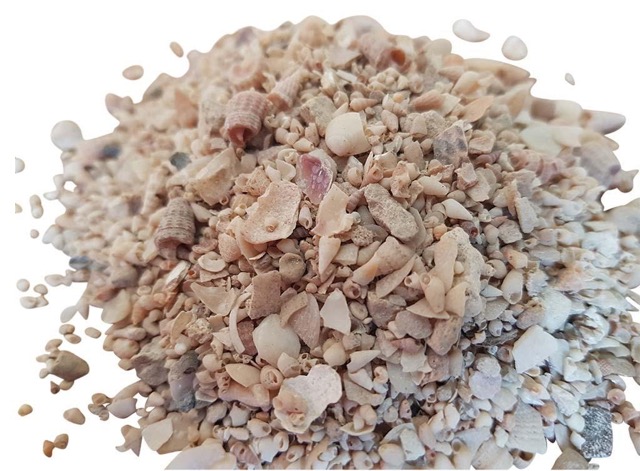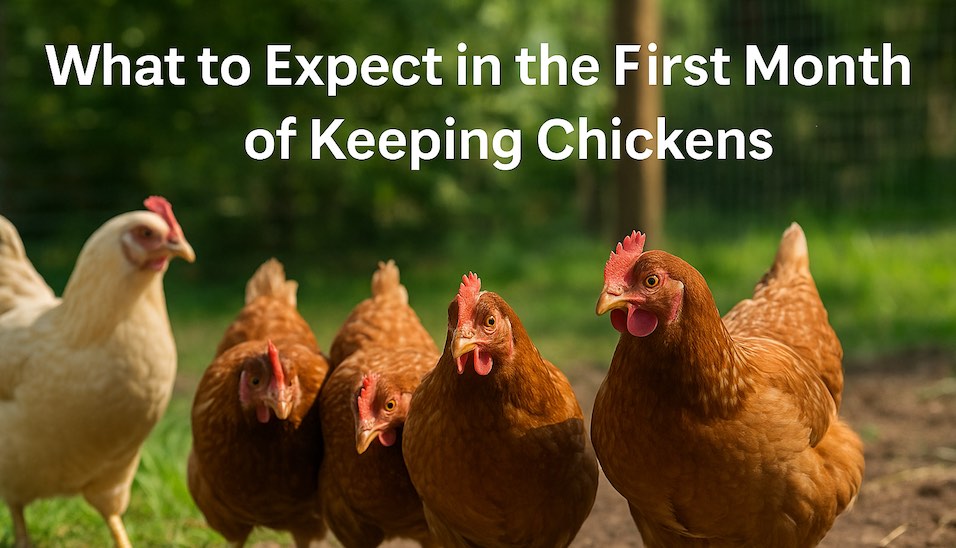Calcium for Chickens - Recognise and Avoid Deficiencies
Everything You Need to Know About Calcium for Laying Hens
Calcium is an essential nutrient for laying hens. In fact, after protein and amino acids, calcium is one of the most important nutrients for maintaining regular egg production. But it isn’t just about eggs. Providing your hens with plenty of calcium is also essential to their overall health.
1. What is the Importance of Calcium for Chickens?
Calcium is an essential mineral for chickens, contributing to bone health and other physiological functions.
In the body, calcium is important for:
- Bone health: Calcium is needed to grow and maintain strong bones. Insufficient calcium can lead to brittle bones, osteoporosis, and increased risk of fractures. Leg and keel bone issues are often associated with calcium deficiency in laying hens.
- Egg production: Calcium is essential for eggshell formation. Insufficient calcium not only results in thin-shelled eggs, chickens can draw calcium from their bones to produce eggshells, leading to bone issues.
- Muscle function and growth: Calcium is crucial for muscle contraction and growth, contributing to normal movement and preventing muscle spasms.
- Nerve function: Proper nerve function requires calcium to help transmit nerve impulses. Severe deficiency can lead to neurological problems, including paralysis.
- Blood clotting: Calcium is necessary for blood clotting, ensuring wounds heal properly and preventing excessive blood loss.
- Nutrition: As well as contributing to digestive function, calcium is important for the absorption of other essential minerals, such as phosphorous. As phosphorous is naturally deficient in Australian soils, ensuring chickens have sufficient calcium to absorb and use phosphorus is particularly important.
2. Calcium and Egg Production
Eggshells are 40% calcium, containing about 2.2 grams of calcium each in the form of calcium carbonate. The calcium in eggshells is obtained from both the hen’s diet and their bones. There is even a special type of bone involved in this process, called the medullary bone, which forms a calcium reservoir.
Ideally, as much eggshell calcium as possible should be drawn from the diet. However, during peak eggshell formation a hen is unable to absorb the calcium from feed rapidly enough to meet requirements, so the amount is made up by calcium drawn from the skeleton.
After eggshell formation ceases, calcium from the diet is used to restore bone calcium. Because this restoration is never 100% complete, even in ideal circumstances, it is essential that hens are able to draw as much calcium as possible from their diet during and after eggshell production.
30-40% of the calcium in an eggshell can been drawn from the bones and hens have the capacity to draw up to 10% of the total calcium in their skeleton for eggshell production. Hens with a calcium-deficient diet can deplete their skeletal calcium stores by up to 40% before they cease laying altogether!
3. Signs of a Calcium Deficiency in Chickens
A severe calcium deficiency can cause serious health issues, including death, in chickens of all ages. But for most backyard chicken keepers, calcium deficiency most commonly presents as thin-shelled eggs or reduced laying.
Early Signs of Calcium Deficiency in Laying Hens
The most common symptoms of a calcium deficiency in laying hens include:
- Thin-shelled eggs
- Small eggs
- Soft-shelled eggs
- Reduced egg production
- Not laying
- Egg binding
- Unusual feather loss
- Feather pecking and/or feather eating
- Egg eating
- General ill health
Bone weakness, which is also the result of a calcium deficiency in hens, may be recognised by signs such as:
- Brittle bones
- Fractures, particularly to leg and keel bones
- Weak legs, including inability to roost, stand or walk
- Deformed legs
- Older hens beginning to roost in nesting boxes
Symptoms of Severe Calcium Deficiency in Chickens
Extremely low levels of calcium in the blood is called hypocalcaemia or calcium tetany. Heat stress can trigger hypocalcaemia, but the condition usually only occurs in commercial flocks. In a backyard flock with an adequate diet, severe calcium deficiency is less common. Typically, birds with hypocalcaemia present with panting, spread wings and prostration early in the morning, followed quickly by paralysis and death.
Calcium Deficiency in Chicks
Chicks can also be affected by calcium deficiency, which presents as rickets. Chicks with rickets will not develop normally. Their growth may be stunted and they may limp or go lame, usually within a couple weeks of hatching. Bones may be rubbery, including the beak and toes. The keel bone may be twisted or limbs deformed.
Do All Laying Hens Have a Calcium Deficiency?
The short answer to this question is 'No'. Not all laying hens suffer from calcium deficiency.
The cycle of calcium usage and bone development in chickens is natural and shared by many other bird species. But because modern hens are so incredibly productive – remember, the Jungle Fowl only lays about 14 eggs a year in the wild! – long-term egg laying will eventually result in bone weakness.
Cage layer fatigue is typical in highly productive hens, such as ISA Browns, that lay 200-230 eggs in a row. So from a long-term health perspective, chickens that produce an egg a day consistently are more likely to suffer from calcium deficiency eventually, simply due to the toll egg production takes on their body.
Older layers, even of less productive breeds, do typically have some symptoms of calcium deficiency due to the use of bone calcium over time. You will notice that older hens may have a tendency to lay thin-shelled eggs or display some bone weakness. Roosting in nesting boxes or on other flat surfaces, rather than roosts, is a common symptom.
While ensuring your chickens have a calcium-rich diet can reduce the impact of calcium deficiency, it is difficult to avoid completely in older hens.
4. Dietary Calcium for Chickens
It is vital that laying hens consume enough calcium to support eggshell formation and bone health. However, the amount of calcium required varies depending on the breed, level of production, age, individual genetics and even stage of the laying cycle.
As hens have been bred to be more productive, calcium requirements have increased from a recommendation of around 2.75 grams of calcium per hen per day in the 1960s to 4-5 grams of calcium today.
An eggshell takes 20 hours to form. Because hens typically lay earlier in the day, the most calcium-intense period of eggshell development usually happens overnight, while chickens are roosting. Therefore, it is essential that chickens consume calcium prior to roosting.
Providing the Right Type of Calcium for Laying Hens
Chickens need a combination of small and large particle calcium in the diet for optimum eggshell quality and bone health.
Small particle calcium is highly soluble, so it is more readily available for eggshell production and any excess is stored in the bones. This includes ground limestone, calcium supplements and crushed eggshells.
Large particle calcium (greater than 2 mm) is stored in the gizzard and calcium is released more slowly. Large particle calcium provides calcium overnight when hens are roosting and contributes to better bone health. 65-70 % of dietary calcium should be available in large particle form. Large particle calcium can be chipped limestone, oyster shell or Shell Grit.
Chickens should be fed a complete layer feed, which technically contains all of their daily calcium needs. However, the calcium in chicken feed tends to be mostly small particle calcium, such as ground limestone. This is why it is essential that laying hens are also provided with Shell Grit or another large particle calcium source.
There are other benefits to providing a large particle calcium source alongside a complete feed:
- Where feed is low in calcium and another source is not available, chickens may eat more to try to meet their needs, becoming overweight and increasing feed costs
- Where feed is high in energy or chickens have lots of treats or scraps, hens may become full and stop eating before they have consumed enough calcium, leading to deficiency
- Free-choice Shell Grit or another large particle calcium source, provided separately from feed, allows chickens to consume calcium to meet their individual needs
- If you feed your chickens treats, this dilutes the calcium in their diet, making extra calcium even more important!
Never mix Shell Grit or another large particle calcium source with feed. Although large particle calcium is essential, it should always be provided separately from feed. By allowing hens to consume Shell Grit when and as they like, this ensures they can regulate their own calcium intake.
Other Nutrients That Influence Calcium Absorption
Calcium absorption is also influenced by dietary levels of phosphorous and vitamin D3.
Phosphorous is important for eggshell quality and bone health. Calcium and phosphorous must be balanced for optimum health, as too much or too little phosphorous can interfere with calcium absorption. Usually, adequate phosphorous is available in a diet of complete layer feed, although chickens with a vegetarian diet can suffer from phosphorous deficiency. Insects such as Black Soldier Fly Larvae are a good way to boost calcium and phosphorous, containing both minerals in an ideal ratio for laying hens!
Vitamin D3 comes from sunlight and is essential for calcium utilisation. Chickens with outdoor access usually get plenty of vitamin D3 from sunlight, although if you are supplementing calcium due to a deficiency, adding D3 can be a good idea.
Vitamin D3 is mostly responsible for calcium deficiency in brooder-raised chicks displaying signs of rickets, and in that case a Calcium D3 supplement may be effective.
5. Steps to Ensure Your Chickens are Consuming Enough Calcium
Follow these simple steps to ensure your chickens are getting enough calcium in their diet:
- Feed your chickens a complete layer feed and let them eat as much as they like
- Provide unlimited, free-choice access to a large particle calcium source, e.g. Shell Grit, separate from feed
- No more than 10 % of the diet should be scraps or treats, and avoid forage high in oxalic acid, e.g. spinach
- Boost calcium with leafy brassicas, e.g. kale and broccoli, and Black Soldier Fly Larvae
- As most eggs are formed overnight, encourage chickens to fill up on layer feed before roosting - no treats in the afternoon!
- Ensure your birds get plenty of sunlight or add a D3 supplement
Never mix Shell Grit or calcium with feed or treats. And never provide layer feed or calcium supplementation, even in the form of Shell Grit, to chickens under 16 weeks of age.
Special Tips for Summer
Hypocalcaemia is more common in hot weather. In hot weather, feed intake decreases so that hens are consuming less calcium. Furthermore, heat stress makes calcium less available in the bloodstream.
In summer, do everything you can to keep your hens cool. Provide electrolytes in the water during heat waves and speak with your vet about whether a liquid calcium supplement could be beneficial.
Planning for Bone Weakness in Older Laying Hens
Even a mild calcium deficiency, caused by normal egg production in chickens, will weaken bones over time. Many older laying hens have some bone weakness for this reason. While issues such as fractures are common, there are ways to prevent bone deterioration and injuries.
Exercise and activity contribute to the development and maintenance of strong, healthy bones. Safe opportunities to run, jump and fly should be provided from the second week of life through to old age. However, because older layers are prone to injury, it is also important to design coop features to protect bones from fracture-causing impacts:
- Ensure roosts and nesting boxes are no more than 1 m from the ground
- Provide a soft landing by covering solid floors with litter or mulch
- Ensure roosts are at least 5 cm wide with flat or gently curved surfaces
- Wrap roosts with rubber or cloth to prevent keel bone damage and fractures caused by impact with the roost
- Provide a platform roost with easy access for older hens
6. Too Much Calcium? Avoiding Excess
Too much calcium for chickens can be as harmful as too little.
In small amounts, surplus calcium simply passes through the digestive tract unabsorbed. But excessive amounts of calcium interfere with kidney function and can cause leg issues, impaired mobility and death.
Calcium toxicity rarely occurs in laying hens, except where additional calcium is mixed with the layer feed. This is why calcium supplements like Shell Grit should be provided separately and free-choice unless a deficiency has been identified. However, if you are seeing lots of pimply eggshells, your flock may be getting too much calcium and the diet should be assessed.

Unfortunately, calcium toxicity is common in chicks and non-laying birds that are fed a complete layer feed. This is because layer feeds contain about 3 times the amount of calcium that non-laying chickens need.
For moulting hens, consuming a layer feed is ok because they will still be replenishing bone calcium as well as growing feathers. Roosters also generally cope with layer feed, although it is less than ideal.
But chicks and pullets are particularly sensitive to excess calcium and should never be fed layer feed before point-of-lay (16-18 weeks). If young birds are fed a layer feed, in addition to immediate health issues, they are likely to have shorter, less productive lives than if they were fed an appropriate feed such as Starter or Grower Feed.
Happy chicken keeping!
Rachael at Dine a Chook Australia





